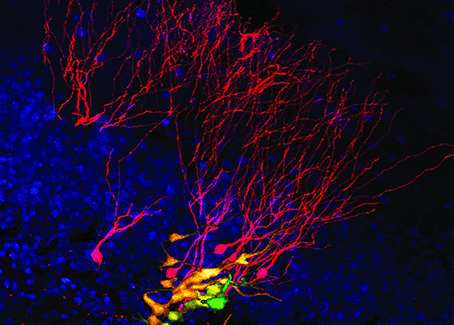An individual neural stem cell (green) and its daughter neurons (depending on the age shown in yellow, orange and red) that were generated over the course of 2 months within the adult hippocampus. Credit: UZH
Scientists from the University of Zurich have succeeded for the first time in tracking individual stem cells and their neuronal progeny over months within the intact adult brain. This study sheds light on how new neurons are produced throughout life.
The generation of new nerve cells was once thought to taper off at the end of embryonic development. However, recent research has shown that the adult brain can generate new nerve cells throughout life. One of the areas where this happens is the hippocampus, a brain structure that determines many types of learning and memory, determining what is remembered and what is forgotten.
In a new study published in Science, the laboratory of Sebastian Jessberger, professor in the Brain Research Institute of the University of Zurich, has shown for the first time the process by which neural stem cells divide and newborn neurons integrate in the adult mouse hippocampus. The study, led by postdoc Gregor Pilz and Ph.D. student Sara Bottes, used in vivo two-photon imaging and genetic labeling of neural stem cells in order to observe stem cell divisions as they happened, and to follow the maturation of new nerve cells for up to two months. By observing the cells in action and over time the team showed how most stem cells divide only for a few rounds before they mature into neurons. These results offer an explanation as to why the number of newborn cells dramatically declines with advancing age.
Imaging over two months of two individual neural stem cells in the adult hippocampus that get activated at distinct time points (d, days after recombination) and generate neuronal progeny. Credit: UZH
"In the past, it was deemed technically impossible to follow single cell stem cells in the brain over time given the deep localization of the hippocampus in the brain," said Jessberger. The study answered longstanding questions in the field, but the researchers say that this is just the beginning of many more experiments aimed at understanding how human brains are able to form new nerve cells throughout life. "In the future, we hope that we will be able to use neural stem cells for brain repair—for example for diseases such as cognitive aging, Parkinson's and Alzheimer's disease, or major depression," says Jessberger.
More information: G.-A. Pilz el al., "Live imaging of neurogenesis in the adult mouse hippocampus," Science (2018). science.sciencemag.org/cgi/doi … 1126/science.aao5056
Journal information: Science
Provided by University of Zurich
























